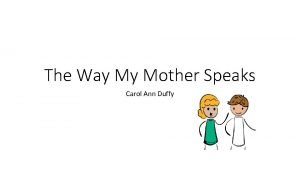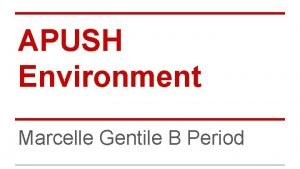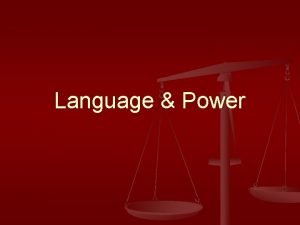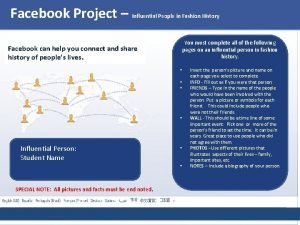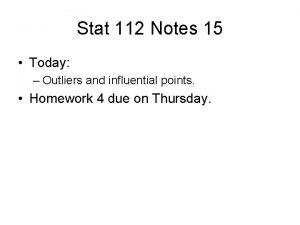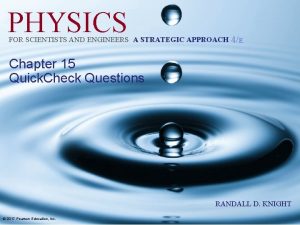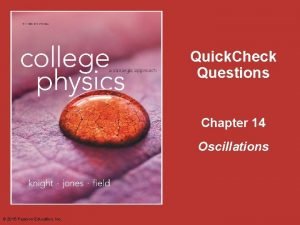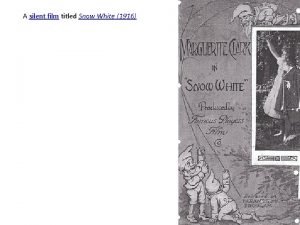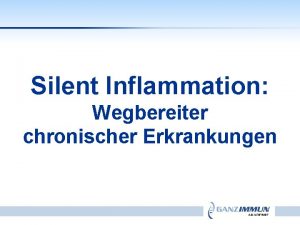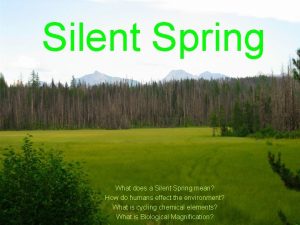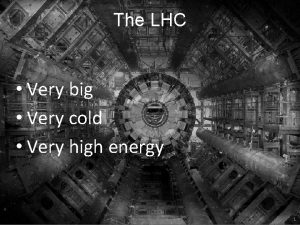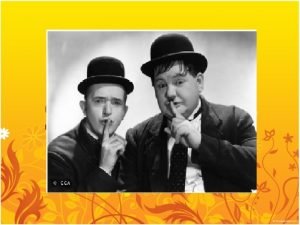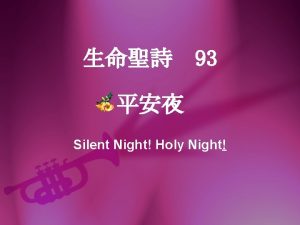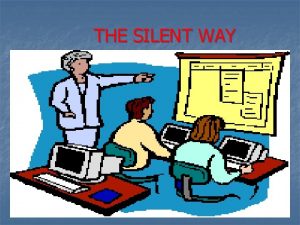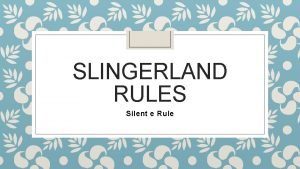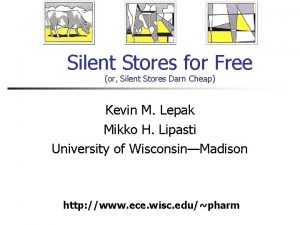from Silent Spring was very influential in environmentalism
















- Slides: 16

from Silent Spring was very influential in environmentalism. It brought problems caused by misuse of pesticides to wide attention. View- https: //video. search. yahoo. com/yhs/search? fr=yhs-elm-001&hsimp=yhs 001&hspart=elm&p=silent+spring+video+clip#id=2&vid=d 201 ca 130 fb 92 c 9 a 7 ac 5 d 70 dcb 22557 e&action=view https: //www. youtube. com/watch? v=Ipbc-6 Iv. MQI

Did you know? ! 27, 000 trees are cut down each day so we can have Toilet Paper. Aluminum can be recycled continuously, as in forever. Recycling 1 aluminum can save enough energy to run our TVs for at least 3 hours. 80 trillion aluminum cans are used by humans every year. American companies alone use enough Paper to encircle the Earth 3 x! (It’s a good thing that businesses are moving towards going paperless) We can save 75, 000 trees if we recycled the paper used on the daily run of the New York Times alone. When you throw plastic bags and other plastic materials in the ocean, it kills as many as 1 million sea creatures annually. A glass bottle made in our time will take more than 4, 000 years to decompose. Only 1% of our planet’s water supply can be used. 97% is ocean water and 2% is frozen solid in the Arctic, for now. Our planet gains inhabitants numbering to 77 million people a year. An estimated 50, 000 species inhabiting our tropical forests become extinct annually. That’s an average of 137 species a day. Rainforests are cut down at a rate of 100 acres per minute. The world’s oldest trees are more than 4, 600 years old. Landfills are composed of 35% packaging materials. http: //www. theworldcounts. com/stories/amazing_environmental_facts

According to Ban the Bottle… Why is bottled water a concern? Here are just a few reasons… • Making bottles to meet America’s demand for bottled water uses more than 17 million barrels of oil annually, enough to fuel 1. 3 million cars for a year 1. And that’s not even including the oil used for transportation. • The energy we waste using bottled water would be enough to power 190, 000 homes 2. • Last year, the average American used 167 disposable water bottles, but only recycled 38. 3 • Americans used about 50 billion plastic water bottles last year. However, the U. S. ’s recycling rate for plastic is only 23 percent, which means 38 billion water bottles – more than $1 billion worth of plastic – are wasted each year 3. • The recommended eight glasses of water a day, at U. S. tap rates equals about $. 49 per year; that same amount of bottled water is about $1, 400. • Antimony, which is found in PET plastic bottles, in small doses can cause dizziness and depression; in larger doses it can cause nausea, vomiting and death. 8

Essential Question In your ELA Writer’s Notebook, answer the following questions and be sure to fully support your ideas in a well-developed paragraph…. Be prepared to share 1. What effects do people have on the environment? 2. Is it too late to fix the damage that has been done to our environment?

Possible answer…. warming up 1. When people release the wrong kinds of chemicals into the environment, all kinds of animals and plants can die 2. Some of the environmental problems of Rachel Carson’s day have now been fixed. Several species of birds of prey nearly went extinct in the US due to DDT, but their populations are recovering

First Read 1. NOTICE the general ideas of the text. What is it about? Who is involved? 2. CONNECT ideas within the selection to what you already know and what you have already read. 3. ANNOTATE by marking vocabulary and key passages you want to revisit. 4. RESPOND by completing the Comprehension Check and by writing a brief summary of the selection. NOTICE: notice what happens to the town, the area around it, and the people who live there as the story progresses. ANNOTATE: mark passages you feel are worthy of analysis in their close read. For example, focus on Carson’s language or on specific changes that affect the town or the people. CONNECT: make connections beyond the text. If you cannot make connections to your own lives or other texts, consider news reports, movies, and TV shows. RESPOND: write a summary to demonstrate understanding.

Consider… 1. NOTICE: notice what happens to the town, the area around it, and the people who live there as the story progresses. 2. ANNOTATE: mark passages you feel are worthy of analysis in their close read. For example, focus on Carson’s language or on specific changes that affect the town or the people. 3. CONNECT: make connections beyond the text. If you cannot make connections to your own lives or other texts, consider news reports, movies, and TV shows. 4. RESPOND: write a summary to demonstrate understanding.

Answer the following questions on a separate sheet of paper in complete sentences… 1. What are two animals that attracted visitors to the town? 2. What happened to the animals and the people in the town? 3. What fell on the roofs, lawns, fields, and streams? 4. Notebook Write a brief summary of the excerpt from Silent Spring.

Next step-reread… Revisit a section of the text you found important during your first read. Read this section closely and annotate what you notice-draw a box around the section. Ask yourself questions such as “Why did the author make this choice? ” What can you conclude? Be sure to list answers…

Answer the following questions… 5. a. In paragraph 1, what does the phrase “heart of America” suggest? (b) Why do you think Carson used this phrase in the first paragraph? 6. In the book, the excerpt you read is called “A Fable for Tomorrow. ” Why do you think Carson used this title for this section of the book? 7. What effects do people have on the environment? What have you learned about the effects people have on the environment by reading this selection?

Analyze Craft and Structure Analyze Word Choice: Imagery An image is a word or phrase that appeals to one or more of the five senses. A writer uses imagery to bring his or her writing to life with vivid descriptions of how the subjects look, sound, feel, taste, and smell. A writer’s word choice, or the specific words, phrases, and expressions he or she uses, contributes to memorable imagery. Look at the following examples of imagery, and note the ways in which the individual words help to create a realistic image for readers: • The phrase “the sweet, slippery mango slices” appeals to the senses of taste and touch. • The phrase “glaring lights and wailing sirens” appeals to the senses of sight and hearing. Writers also create mood through their use of imagery, word choice, and descriptive details. Mood is the feeling created in the reader by a piece of writing. The mood of a work may be described with adjectives such as joyous or frightening. To fully appreciate images and experience the mood of a text, use these strategies: • determine the specific meanings of unfamiliar words • consider the connotations, or emotional associations, of words as well as their figurative, or nonliteral, meanings • analyze the author’s word choice, and make inferences, or educated guesses, as to why the author may have chosen certain words The use of imagery to create mood can be a powerful way to develop central ideas in a text. As you review the excerpt from Silent Spring, notice how Carson uses word choice, imagery, and mood to make her central idea more powerful and compelling.

Answer…. 8. Review the selection. Then, list images in the text and the sense to which each image appeals. For example: a checkerboard of prosperous farms = sight 9. (a) A scepter is a source of terror or dread. Why might Carson have chosen to use this word in the last sentence of the excerpt? (b) What mood does this word choice create? 10. How does Carson’s use of imagery to create mood develop the central idea of the excerpt? Cite at least two textual examples to support your response.

Conventions Verb Mood— The subjunctive mood can express the speaker’s belief that the action is contrary to fact. It can also express the speaker’s wish or demand that the action be taken. The indicative mood is used for statements of fact. By contrast, the subjunctive mood is used to express a wish, a hope, or a statement contrary to fact. It is also used to express a request, a demand, or a proposal. The subjunctive is often found in a clause beginning with if or that

Examples

Rewrite the following correctly Identify the incorrect verb form in each sentence, and rewrite the sentence correctly. 11. Carson wishes that she was wrong about the fate of the town. 12. The situation Carson relates seems to demand that I am more aware of my effects on the environment. 13. Write a paragraph in which you correctly use verbs in the subjunctive mood. For example, you might write a request for assistance or about a hope you have for the future.

Writing In the excerpt from Silent Spring, Rachel Carson paints a harsh picture of the future. Does she inspire readers to take action? 14. a. State your view on pesticides… b. Was it difficult to determine your position? 15. Find evidence, details, and examples to support your position and list.
 Climate change definition ap world history
Climate change definition ap world history Restful shapes moving
Restful shapes moving Homesteaders apush
Homesteaders apush Influential and instrumental power
Influential and instrumental power Influential people in fashion
Influential people in fashion Europe physical characteristics
Europe physical characteristics Outliers and influential points
Outliers and influential points Kim ki duk summer fall winter spring
Kim ki duk summer fall winter spring Summer spring winter fall
Summer spring winter fall A block oscillates on a very long horizontal spring
A block oscillates on a very long horizontal spring A block oscillates on a very long horizontal spring
A block oscillates on a very long horizontal spring Used to express very large or very small numbers
Used to express very large or very small numbers Fewfewfewf
Fewfewfewf Very little very few
Very little very few Receiving table/area
Receiving table/area Very bad to very good scale
Very bad to very good scale Snow white silent film
Snow white silent film

